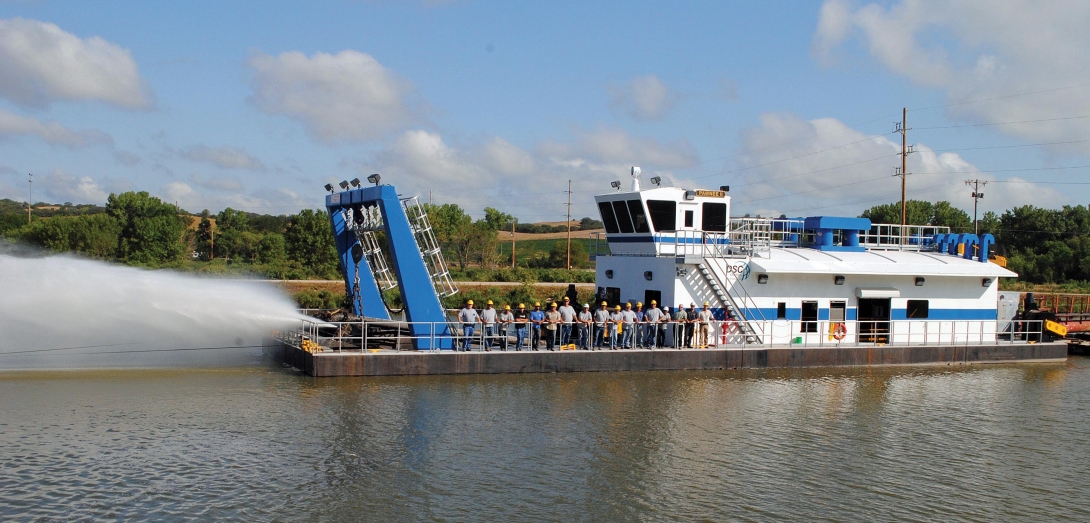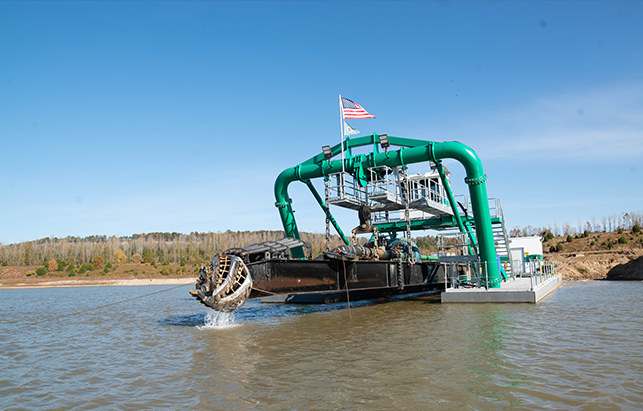The Challenge
Loup Power District had growing concerns about its original, 75-year-old dredge, which was required to provide continuous, 24/7 desilting of materials from a settling basin in Loup Power Canal.
Our Solution
In 2012, the Loup Power District commissioned its new electric-powered DSC dustpan custom dredge, the Pawnee II, and retired the dredge it had been using for the past 75 years. As you can imagine, technology had advanced significantly since the early days of the original Pawnee, allowing the crew modern amenities and computer-based technology.
The Loup Power District provides electricity for about 19,000 residential and commercial customers in a four-county area in central Nebraska. It serves 21 towns, the largest of which is Columbus, where the company is headquartered. A diversion wall in the Loup River redirects a portion of the water into the 35-mile Loup Power Canal system, where it is carried to the hydroelectric powerhouses at Monroe and Columbus, before returning it to the Platte River just beyond the confluence with the Loup River. The first two miles of the canal, known as the Genoa Headworks, contains a desilting operation consisting of a settling basin and the Pawnee II dredge.
Currently, 14 Loup Power District employees work at the headworks, eight of whom are assigned to the dredging operation. The dredge constantly faces into the flow of the water so that the dredging operation begins on the downstream end of the basin and proceeds upstream. Between 1 and 1.5 million cubic yards of sand and sediment are removed from the settling basin annually. During the two operating seasons, the dredge must continuously remove materials from the basin, 24 hours per day, seven days per week,to prevent any sand or sediment from building up and passing through to the power generation plants.
“The river water is heavy-laden with sand and sediment from runoff,” says Brad Morton, hydro superintendent for the Loup Power District. “In the two-mile settling basin where our dredge operates, the pumping stations are placed about 300 feet apart on both sides, allowing the dredge to move up and down the basin.”
Choosing A New Dredge
After seven-and-a-half decades of aggressively operating the original Pawnee dredge, maintenance was becoming increasingly difficult. Periodic inspection and repair helped to extend its life, but eventually the possibility of a sudden shutdown motivated the action to begin the search for a new dredge.
“Choosing a new dredge was a long process,” comments Kendall Christensen, operations manager for the Loup Power District. “We attended some dredging conferences and visited with several dredge manufacturers. We even hired a consultant, who helped us understand the newer touch-screen technology. The new dredge would have to work with the existing pipeline and infrastructure, as well as fit in the existing dry dock area.”
The Loup Power District did its research and narrowed its selection by sending out four or five bid packages to dredge manufacturers. The final choice came down to DSC Dredge because of the company’s entire package, from the unique dredge design to the support that it offered post-placement. DSC’s extensive experience making customized dredges also allowed it to come in with a lower bid for this dustpan dredge, which is possibly the first one made in the U.S. in over two decades.
“A dustpan dredge operates much like a vacuum cleaner, sucking up sediment from the bottom of the canal,” explains Christensen. “It was custom-built for our operation, and is probably the first dustpan dredge to be built in the United States in 25 to 30 years. The technology today is mostly cutter head [design], but the dustpan design suited our operation needs best.”
Conquering The Learning Curve
After 75 years of dredging with the original Pawnee, the Loup Power District dredge crew faced a heavy learning curve, due to the change in technology. To help prepare the crew, “DSC held classes – both in the classroom and on the dredge, which helped considerably,” Christensen says. “It helped us understand some of the parameters we’re dealing with now. We’re doing the same job we did before, but now we receive feedback from the equipment, which wasn’t available before.”
“On the old dredge, everything was mechanical,” Christensen adds, “you could grab a wrench and fix it. Now, everything is either electrical or PLC-driven, and maintenance personnel need specific training to make the necessary repairs. Equipment is more sensitive and has a tighter spec. There are sensors, meters and gauges telling you how everything is running.”
Dredging Technology
DSC’s custom dustpan dredge features state-of-the-art technology, with a PLC-based (programmable logic controller) control system, which allows for simple, user-friendly operation. A PLC-based system means that operators can rely on a computer to monitor and manage basic functions of the dredge. As an example, the PLC-based system monitors the engine speed and will not allow the pump to be engaged unless it is at idle, protecting the pump and driveline from potentially significant damage.
In addition, the PLC-based system records and displays operating hours for all the major equipment on the dredge – pump, cutter, swing/positioning winches and ladder winch – which helps the crew track usage and schedule maintenance.
The Pawnee II is equipped with a powerful 3,000-horsepower (4160V) electric motor to power the 35,000 gallon-per-minute dredge pump. The original Pawnee pump ran at a constant speed, which did not allow the dredge to adapt to changing conditions. The Pawnee II, however, features a variable frequency drive (VFD), which allows the operator to easily adjust dredge pump speed to accommodate bank conditions and required feed rates, as well as starting and stopping the dredge pump for servicing or shutdown. This extra level of operational ease helps operators to devote the majority of their attention to other external factors that they might not have been able to previously.
The water jet system that dislodges the materials for dredge pump ingestion on the new dredge features a series of high-pressure nozzles, as well as a VFD for high-flow/low-pressure or low-flow/high-pressure operation, depending on which is preferred. Horsepower on the jet pump motor was increased from 35 HP on the old dredge to 400 HP on the new dredge, a significant jump in power, making a big difference in performance when dredging the 5-feet to 18-feet basin.
Additionally, the VFD-controlled electric winches – four hauling winches and the ladder lift winch – offer optimized operations in variable water current conditions and with variances in dredged materials. A cable reeving system, or level-wind, on the hauling winches ensures proper drum fleeting for less wear and increased longevity of the cables.
After 75 years of operation with the original Pawnee, there was certainly a learning curve with the new Pawnee II. But with thorough post-sale support from the experts at DSC, the crew was quickly up and operational with the new dredge. With its intense dredging schedule, the next news from Loup Power District will undoubtedly be, “Why didn’t we do this sooner?”







